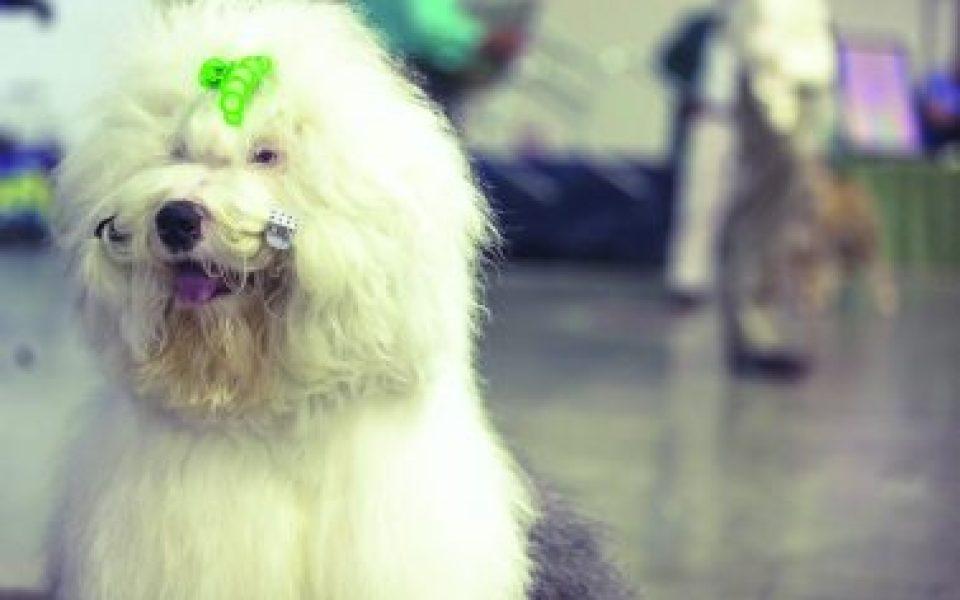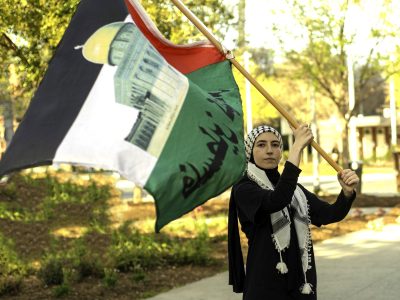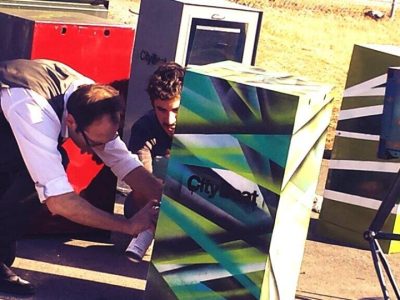A Yorkie named Star prances excitedly on the Astroturf-ed runway, never taking her tiny black eyes off the orange ball in the hand of her owner, Robin Hutson of Greensboro.
Before them, a temporary pool constructed from laminated canvas and PVC pipe catches medallions of white light from the late-morning sun here in the parking lot of the Greensboro Coliseum. Hutson fakes the throw into the pool once, twice, then lobs it into the pool just a few feet from the precipice. Without the benefit of a good running start, Star launches herself into the water and lands five feet out. Nothing close to the record here on the second day of the Carolina Kennel Club’s annual dog show, but not bad for a pooch that’s roughly the size of a loaf of bread.
The next diver, Violet, looks to have some Portuguese water-dog in her bloodline. Unconcerned with the competition, she’s ready to get in now. So one man holds her by the shoulders at the end of the runway as her owner tosses a bundle of sticks to the center of the pool. Violet explodes from the makeshift starting block and covers the distance to the edge in a sprint. But, like almost every other dog that will visit the Diving Dogs tent out here in the lot, she hesitates at the diving platform before jumping in the water.

Still, she makes it 14 feet.

The record so far, says Steve Mize, in from Jefferson, Ga. to run the tent all weekend, was a black lab named Mandy who made 24 feet on the first day.
The Dog Dive is sanctioned by the American Kennel Club, the same organization that governs the dog show circuit ranging from regional conformations like this one, held in the Special Events Center of the coliseum, to the big dance: the Westminster Kennel Club Dog Show, aired live from Madison Square Garden every year on Thanksgiving Day. The blueblood event is the second-oldest annual sporting event in the United States. The first one was held in 1877, just two years after the first Kentucky Derby and seven years before the AKC
The history of the Carolina Kennel Club, like Westminster a member of the national organization, is not quite as illustrious but no less sincere. Founded in 1938 and admitted to the AKC that same year, it is the oldest organization of its kind in the state, and its annual conformation is the Old North State equivalent of the big time.
Most of the dogs jumping into the pool at the coliseum won’t be going inside to watch their fellow canines compete — show dogs are no mere pets but purebreds of their respective breeds. Only dogs with the purest expression of their subset’s attributes make it to these pageant-style conformations, where they are weighed by appearance, temperament and movement. They call them “conformations” because they judge the dogs by their conformity to the standard of each breed. Regular house dogs like Star aren’t even allowed into the lobby.
But they’re welcome to use the pool.
***
These dogs don’t bark.
One might think that a concrete space filled with more than a thousand dogs would be a cacophony of aggressive barks, mournful whines, defeated whimpers. But show dogs don’t do much of that even when they’re penned in cages or being teased with treats.
Show dogs, among their other skills, know how to keep it together.
The Special Events Center has been cordoned off into a dog show village, with fences made from stacked travel cages and crates of supplies. Eight competition rings take up half of the large space, with a couple others in the adjunct on the other side. Three children, two girls and a boy with a bowtie, walk four tiny, scrambling dachshunds down a side thoroughfare cut between the handler’s grooming stations and the vendors that line the room.

Haley Whitcomb, a handler in from Greenville, SC, grooms an Irish setter named Sweeney, fluffing out his red tresses with a special blow-dry unit called the K-9 until the mahogany hue along his back fades gradually to burnt sienna and a creamy white.
“I actually take better care of his hair than I do mine,” she says.
Sweeney is 3 years old, “approaching his prime” Whitcomb says, one of a dozen dogs she and her partner, Jamie Clute, have brought north for their clients. She likes Sweeney’s chances.
“He’s a really nice breed type,” she says. “His fur is rich where it needs to be. He’s just an overall pretty dog.”
At the table next to them, Clute works on a black Russian terrier named Vincent, who is due in the ring in eight minutes, with a hand-dryer and a spiky brush. He’s a large and dignified animal, with thick, coarse fur that droops from his snout like a moustache and covers his eyes in thin forelocks.
“He can see better than you think,” Clute says.
After the teasing, brushing and drying, Vincent looks like he’s wearing a gorilla suit.
The Russians bred these terriers from giant schnauzer, Rottweiler, Newfoundland and other stock for military and law-enforcement purposes. The AKC bullet-points them: “Powerful. Intelligent. Calm.”
Clute knows better.
“These dogs are bred to hurt people,” he says. “They can be really tough. Strong-willed. Sometimes they just downright want to hurt people.”
Vincent seems friendly enough. After his grooming he jumps his forepaws on Clute’s shoulders and looks him directly in the eye.
Clute slips on his suit jacket, affixes his handler number — 11 — around his bicep with a rubber band and brings Victor to his big moment.
It’s Victor’s first show — at just eight months old, he’s only been allowed to compete at this level since June — and the point is more to acclimate him to the ring than to take home a ribbon. Maybe by the time the St. Louis nationals come around in a couple weeks, Clute says, he could start winning.
He walks Victor to the ring with the gait of a ballroom dancer: shoulders square, spine erect, the dog’s bare testicles peeking out from the fur like a couple of small black eggs in a nest.
Today in Ring 9 he’s up against Ricky, a prizewinning Russian terrier whose owner, Sarah Gaunt, is one of the few in attendance this weekend. Most made the trip with trainers and professional handlers like Clute. Gaunt keeps her terriers in Signal Mountain, Tenn. and shows them all year long.
Gaunt, who works for the National Football League’s front office, invites a spectator to feel how solid Ricky is. The dog is built like a bear. Part of his daily exercise regimen, she says, is a four-mile run that helps him keep an even temperament.
“He’s our middle linebacker,” she says. “If this dog does not run three miles a day….” She shakes her head slowly as she trails off.
Victor, Ricky and two other dogs enter the competition ring; one by one they make their paces around it — handlers have to run to keep up with these big dogs — and submit to Judge Cindy Stansell for up-close inspection. Ricky takes Best of Breed; Victor comes in third.
Dogs at the show are broken down into seven categories, Stansell explains afterwards: herding dogs such as shepherds, collies, sheepdogs and corgis; hounds from Afghans to whippets; non-sporting bulldogs and Dalmatians; sporting dogs such as spaniels, retrievers and pointers; working dogs like boxers, pinschers, danes, schnauzers and the black Russian terrier. There are separate categories for terriers and toy dogs, too.
Stansell says she looks beyond the dictates of the breed — though the dog’s physical structure is an essential attribute — to muscle tone and disposition. Grooming, she says, plays a large factor.
“It’s not just the muscle tone,” she says. “It’s the hairdo too.”
Ricky, she says, did not so much as add another win to his portfolio as maintain a standard that the other dogs failed to live up to.
“The other dog was not quite as hard in muscle tone and that substance of body that [Ricky] had,” she says. “This is a size/substance breed. [The Russians] wanted a dog that would survive the winter. They also wanted it to look like a black bear. You know the Russians. If I was judging a toy category, I’d be looking for something else.”
And so it goes, all weekend long: a seemingly endless stretch of single-elimination rounds, breed by breed, leading up to the coveted Best in Show held at the end of the day on Saturday.
***
In the vending ring that’s formed around the Special Events Center, merchants sell leashes, collars, dog beds and blankets. Dog owners can buy keychains with their favorite breeds on them, as well as sequined jackets, T-shirts, stickers, figurines and wall art. Dog-grooming products include shampoos, conditioners, volumizers and finishing spray. Toys are made of rope, bone, fabric and rubber; some of them squeak and some of them do not.
It’s a huge business — the pet industry itself will generate upwards of $60 billion this year, and in this specialty niche the numbers get big real fast.
Jamie Clute, the handler, will spend the rest of the summer and fall showing other people’s dogs. He gestures to his friend Dennis Brown, who handles the grand champion German shepherd named Rumor Has It. She’s won the Working Dog category in every show she’s been in since 2012, with a slew of Best of Breed and Best in Show designations under her collar. She’s already on the short list for Best of Breed at Westminster, and Clute says her relentless touring schedule until then could run her owners upwards of $300,000 this year.

He’s been around the business since he was a kid, he says, and that all of the pro handlers know each other from the circuit. They’re living this week in an RV compound on coliseum property, as they’ll do in Atlanta the next weekend, and in Lexington, Ky. the week after that.
“It’s pretty much a carny,” he says.
He pulls out an inch-thick copy of this year’s Canine Chronicle, an industry mag with content about breeds, show etiquette and animal issues, and also loads and loads of full- and multi-page ads for individual dogs: a schnauzer named Asta (“This Girl is on Fire!”), a standard poodle named Markie and her trainer Michael (“Making More Magic!”), a fuzzy Norwich terrier by the name of Ted (“Type, Attitude and This Face Too…”). Rumor Has It’s ad is a two-page spread with shots from the winner’s circle and a main photo of the dog with her tongue hanging out, standing alert on an impossibly green, clipped lawn.
“If you’re serious about this,” Clute says, “you need to have an ad in the Chronicle.”
The first story, a deep dive about the Airedale, doesn’t begin until page 114.
Out in the competition rings, the field narrows.
In Ring 3, the terriers line up biggest to smallest, 19 of them in all: an Airedale, a blue, a pit bull, a cesky and one of those bedlingtons, with eyes on the sides of its head like a llama.
Apollo, a Manchester terrier, takes the category and will move on.

In Ring 5, Clute handles Sweeney, the lustrous Irish setter, against four other dogs of the same breed. Sweeney loses out to another setter with a better haircut.
In Ring 9, the great Danes run in a circle like a herd of trick ponies as the Best in Breed shows warm up.
The big moment is sort of anticlimactic: 1,200 dogs have been whittled down to seven, and most of the groomers, handlers and owners have left the building. What’s left are the crews behind the winning dogs, some industry types and a few dozen spectators in the bleachers.
A haircut prevails in the non-sporting category, too, when a manicured poodle with tufts at his ankles, tail and haunches takes the breed. An English sheepdog that looks like a full-sized person in a dog suit takes herding, and a whippet named Brazen that looks like a curved bow takes the hounds. More dogs advance: a boxer for the working dogs, a wobbly Pekingese for the toys. Haley Whitcomb, Clute’s partner from Greenville, shows a golden retriever in the sporting category against the setter that beat her Sweeney. Both of them get knocked out by a black cocker spaniel named Time to Thrill.
In addition to the whippet, boxer and black spaniel, there is the manicured poodle, the Pekingese, a toy Manchester terrier and Rumor Has It.
Judge Don Evans is clearly smitten with the German shepherd, pausing to admire her profile as she awaits his hands. The Pekingese, named General Tso, shows well, too, providing comic relief with its wiggly struggles to move across the runway.
But Evans awards the coveted blue ribbon to the whippet named Brazen, who owner Amanda Giles says was born to be a champion.
“She’s an amazing representation of the breed,” Giles says after accepting the ribbon on behalf of the dog. “She’s in beautiful condition. And she has an athletic tone.”
The dog’s a big deal. She would go on to win Best in Show this past weekend in Massachusetts, her 38th in the last two years. Bitch even has her own Facebook page.
Out in the parking lot, a little black lab in a Thundershirt excitedly barks her way to the platform of the diving pool. She runs full speed after the ball her owner throws into the water, but like almost all of the others she hesitates at the point of launch, mustering a last-minute effort to put her about six feet out from the ledge.
She then swims in the water for a while before padding up the ramp and shaking off, blissfully unaware that her jump was sub-par at best.
Join the First Amendment Society, a membership that goes directly to funding TCB‘s newsroom.
We believe that reporting can save the world.
The TCB First Amendment Society recognizes the vital role of a free, unfettered press with a bundling of local experiences designed to build community, and unique engagements with our newsroom that will help you understand, and shape, local journalism’s critical role in uplifting the people in our cities.
All revenue goes directly into the newsroom as reporters’ salaries and freelance commissions.





Leave a Reply